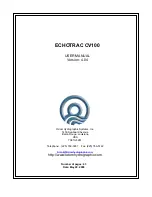
Operation Manual
FarSounder, Inc.
F31552 (Rev. 3.8.0)
Page 62 of 69
Figure C.2. An example of echo sounder interference as seen in the Hydrophone Data display
Figure C.3. An example of echo sounder interference as seen in the Hydrophone Data display
3. Bubble Cloud/Wake Interference
Bubbles make really good sonar reflectors. This means that bubbles will interfere with any sonar by creating
echo returns at the bubble's location and blocking sound from passing through a bubble cloud. This effect
is not unique to FarSounder sonars. Rather this effect is true for all sonar technologies. Bubble clouds
consisting of large bubbles tend to reflect echos back to the sonar and prevent sound energy from continuing
beyond the bubble cloud. Bubble clouds consisting of small bubbles tend to dissipate the sound energy
by dispersing the echos in many directions. They also prevent sound energy from continuing beyond the
bubble cloud, but they don't generally reflect a lot of echo back to the sonar. In both cases, the larger the
bubble cloud, the more energy from the sonar is disrupted. Bubbles are produced by a variety of things
such as waves, vessel wakes, and turbulent current flows around stationary objects like pilings and buoys.
Each of these types of bubbles clouds will effect FarSounder sonars differently.
Waves produce bubbles by forcing pockets of air down into the water column as the waves splash and
break. The bigger the waves, the more air bubbles will be pushed deeper into the water. It turns out, that
most bubbles from most waves most of the time in most waters are in the upper 6 feet of the water column.
This means that the deeper the sonar is installed on the vessel, the better the system will perform in worse
sea conditions. Bubbles created by waves will often show up as in-water targets. They will be transient
(meaning they do not always show up in the same place) and will often be slightly less reflective than
large navigation obstacles. Like radar, higher sea states will cause more interference with the sensor. Like
increasing a radar's wave reject setting, increasing the sonar's In-Water Squelch setting a few decibels
will often remove much of the wave induced “noise” reflections. Also like radar, this will have the cost of























